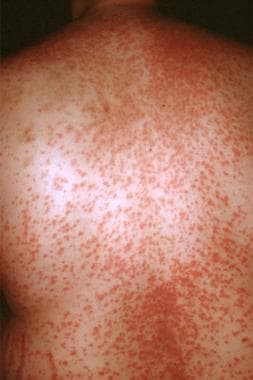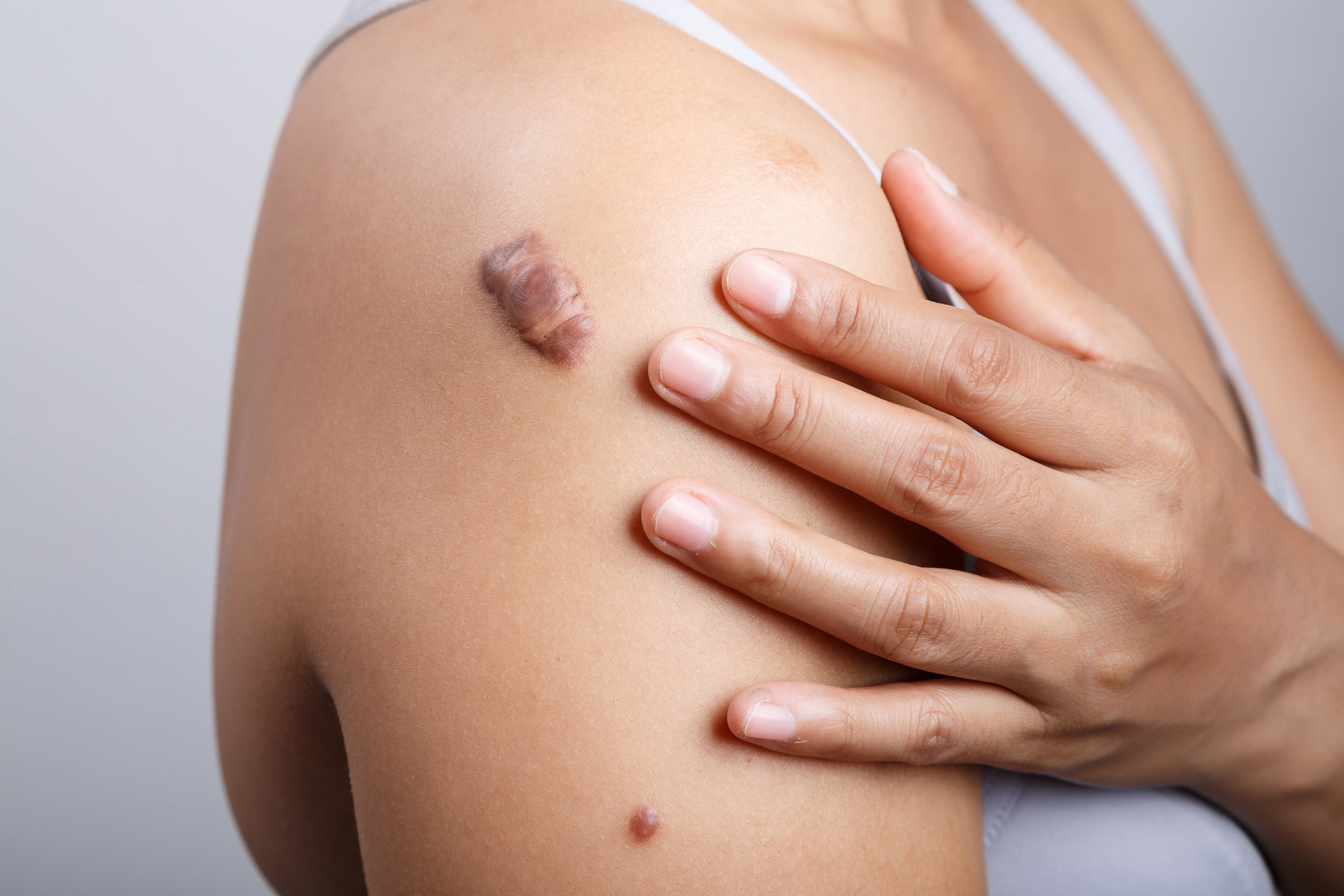Definisi
Pitiriasis rosea merupakan suatu kelainan kulit yang ditandai dengan adanya bercak kulit berbentuk oval yang dapat muncul di berbagai bagian tubuh. Penyakit ini cukup umum terjadi dan dapat memengaruhi orang-orang dari segala usia, meskipun biasanya terjadi antara usia 10 dan 35 tahun. Ruam pada pitiriasis rosea ditandai dengan adanya ruam besar berbentuk oval yang biasanya ditemukan di dada, perut, atau punggung yang disebut sebagai “Herald patch”. Dalam dua minggu atau lebih, ruam tersebut biasanya diikuti dengan perkembangan ruam oval merah kecil bersisik yang penyebarannya menyerupai pohon Natal, sehingga pitiriasis rosea seringkali disebut sebagai Christmas tree rash. Pitiriasis rosea biasanya akan sembuh sendiri dalam waktu sekitar 6 hingga 10 minggu. Kelainan ini bersifat tidak menular dan pada kebanyakan kasus tidak akan meninggalkan bekas atau luka setelah sembuh.
Penyebab
Penyebab pasti dari pitiriasis rosea masih belum diketahui secara jelas. Beberapa kemungkinan penyebab dari pitiriasis rosea adalah:
- Infeksi virus
Virus Herpes 6 dan 7 (HHV-6/7) memiliki hubungan paling kuat yang diketahui terhadap kejadian pitiriasis rosea. Virus HHV-6/7 bukanlah jenis virus Herpes yang dapat menyebabkan timbulnya kutil kelamin pada manusia. Infeksi virus ini cukup umum terjadi, khususnya pada usia dini. Anak-anak sering terinfeksi ketika seseorang bersin atau mencium mereka. Setelah Anda terinfeksi virus ini, maka virus akan tetap berada di dalam tubuh. Virus-virus ini umumnya tidak menimbulkan masalah karena sistem kekebalan tubuh dapat mengendalikannya. Terdapat kemungkinan seseorang terkena pitiriasis rosea ketika sistem kekebalan tubuh sedang melemah, yang dapat memungkinkan virus menyebar ke seluruh tubuh dan berkembang biak.
Infeksi virus lainnya, seperti influenza A H1N1 dan COVID-19, juga diduga dapat menjadi penyebab pitiriasis rosea.
- Reaksi yang diinduksi obat
Banyak obat telah dikaitkan dengan kejadian pitiriasis rosea, seperti golongan penghambat enzim pengubah angiotensin (ACE-inhibitor), obat antiinflamasi nonsteroid (NSAID), hidroklorotiazid, kaptopril, barbiturat antipsikotik atipikal, D-penicillamine, imatinib, metronidazol, isotretinoin, clozapine, dan clonidine.
- Vaksin
Pitiriasis rosea dapat dipicu oleh pemberian beberapa vaksin, seperti Bacillus Calmette-Guerin (BCG), H1N1, difteri, cacar, hepatitis B, Pneumococcus, dan COVID-19.
Faktor Risiko
Beberapa faktor yang dapat meningkatkan risiko terkena pitiriasis rosea, antara lain:
- Usia. Pitiriasis rosea paling sering terjadi pada remaja dan dewasa muda yang berusia 10 hingga 35 tahun, namun pada dasarnya dapat memengaruhi orang-orang dari segala usia.
- Jenis kelamin. Pitiriasis rosea terjadi sedikit lebih sering pada wanita.
- Sebagian besar kasus pitiriasis rosea terjadi di musim dingin.
- Risiko terkena pitiriasis rosea akan meningkat selama kehamilan.
Gejala
Sebelum timbulnya ruam, penderita pitiriasis rosea biasanya akan mengalami gejala seperti flu, antara lain:
- Sakit kepala
- Kelelahan
- Demam
- Sakit tenggorokan
- Batuk
- Kelenjar getah bening di leher mungkin juga terasa bengkak
- Kehilangan selera makan
- Mual
- Sulit tidur
Gejala awal pitiriasis rosea biasanya ditandai dengan munculnya ruam yang disebut “Herald patch”, yaitu ruam tunggal berbentuk oval, besar dengan diameter 2 hingga 5 cm, permukaan yang lebih tinggi dibandingkan kulit sekitar, dan bersisik. Ruam ini seringkali timbul di daerah punggung, dada, atau perut.
Beberapa hari hingga beberapa minggu (sekitar 10 hari) setelah “Herald patch” muncul, ruam lainnya biasanya akan timbul dari bagian atas tubuh ke bagian bawah berupa bintik-bintik bersisik yang lebih kecil dengan diameter 1 hingga 3 cm di punggung, dada, atau perut Anda yang menyerupai pola pohon pinus (pohon Natal). Beberapa ruam juga dapat muncul di paha, lengan atas, dan leher, tetapi jarang terjadi di wajah, kulit kepala, telapak tangan, atau telapak kaki. Ruam pada pitiriasis rosea dapat menyebabkan gatal yang terkadang cukup parah.
Jika Anda memiliki kulit yang gelap, ruam pitiriasis rosea cenderung berwarna ungu kehitaman hingga coklat. Namun, jika Anda memiliki kulit yang terang, kemungkinan besar ruam akan cenderung berwarna merah muda atau menyerupai warna salmon.
Diagnosis
Dalam mendiagnosis pitiriasis rosea, dokter akan mulai melakukan wawancara dengan Anda. Dokter biasanya akan menanyakan gejala-gejala apa saja yang Anda alami, sejak kapan gejala muncul, bagaimana perkembangan dan penyebaran ruam, dan di lokasi mana saja ruam timbul. Selanjutnya dokter akan melakukan pemeriksaan fisik. Dokter akan melihat langsung tampilan ruam dan menilai pola penyebaran ruam. Dokter juga akan meraba kulit untuk menilai permukaan ruam yang biasanya bersisik. Pada dasarnya diagnosis pitiriasis rosea dapat ditegakkan berdasarkan hasil wawancara dan pemeriksaan fisik, khususnya dengan ditemukannya “Herald patch” dan pola penyebaran ruam yang menyerupai pohon Natal. Namun, pada kasus tertentu dokter mungkin menyarankan pemeriksaan tambahan, seperti pemeriksaan kerokan kulit, tes darah, atau biopsi kulit.
Tata laksana
Pitiriasis rosea pada dasarnya dapat sembuh sendiri meskipun tanpa pengobatan khusus. Kebanyakan ruam pada pitiriasis rosea akan mulai menghilang dalam waktu 6 sampai 8 minggu, tetapi bisa memakan waktu hingga 5 bulan atau lebih agar kulit dapat tampak normal kembali. Tata laksana pitiriasis rosea secara umum dapat terbagi menjadi:
- Tata laksana umum
Meskipun pitiriasis rosea adalah penyakit yang dapat sembuh sendiri, tujuan pengobatan yang penting adalah untuk mengendalikan gejala gatal, yang mungkin cukup parah pada 25% kasus. Beberapa langkah yang dapat Anda lakukan antara lain:
-
- Mengoleskan krim pelembab untuk kulit kering.
- Mandi dengan air biasa dan menggunakan krim berbasis air, atau pengganti sabun lainnya.
- Mengekspos kulit ke sinar matahari dengan hati-hati (tanpa terbakar).
- Tata laksana khusus
Pengobatan berikut dapat membantu mengatasi gejala dan mempercepat pemulihan kulit, yaitu:
-
- Krim/salep steroid potensi sedang dan antihistamin oral dapat mengurangi rasa gatal sambil menunggu ruam hilang.
- Untuk penderita dengan gatal yang parah, pengobatan dengan seng oksida, lotion kalamin, dan bahkan steroid oral (tablet) dapat membantu. Penggunaan rutin steroid oral tidak dianjurkan karena terdapat risiko kekambuhan setelah pengobatan.
- Pemberian asiklovir selama 7 hari dapat menyebabkan penyembuhan ruam yang lebih cepat dan membantu meredakan gatal pada kasus yang parah.
- Kasus yang luas atau menetap dapat diobati dengan fototerapi (terapi ultraviolet B sempit)
Komplikasi
Secara umum, pitiriasis rosea jarang menimbulkan komplikasi karena kondisi ini pada dasarnya akan sembuh dengan sendirinya. Namun, pada beberapa kasus, pitiriasis rosea dapat menyebabkan rasa gatal yang sangat hebat. Jika Anda sering menggaruk-garuk ruam dengan terlalu kuat, maka kemungkinan dapat menyebabkan timbulnya luka pada kulit yang dapat memicu timbulnya infeksi kulit. Selain itu, pada penderita pitiriasis rosea yang berkulit gelap, mungkin akan timbul bercak hitam kecoklatan yang akan menetap meskipun ruam telah sembuh.
Pencegahan
Tidak ada cara pasti yang dapat mencegah timbulnya pitiriasis rosea karena penyebabnya yang belum diketahui secara jelas. Namun Anda dapat mencegah timbulnya komplikasi dengan tidak menggaruk ruam terlalu kuat.
Kapan Harus ke Dokter ?
Kebanyakan kasus pitiriasis rosea dapat sembuh dengan sendirinya meskipun tanpa pengobatan. Akan tetapi, jika gejala dirasakan bertambah berat atau menetap lebih dari 3 bulan, maka konsultasikan diri Anda dengan dokter.
Mau tahu informasi seputar penyakit lainnya? Cek di sini, ya!
- dr Nadia Opmalina
American Academy of Dermatology Association. Pityriasis Rosea. Retrieved 23 Mei 2022, from https://www.aad.org/public/diseases/a-z/pityriasis-rosea-overview
Cole, Gary W. Pityriasis Rosea. (2021). Retrieved 23 Mei 2022, from https://www.medicinenet.com/pityriasis_rosea/article.htm
Das, Shinjica. Pityriasis Rosea. (2021). Retrieved 23 Mei 2022, from https://www.msdmanuals.com/professional/dermatologic-disorders/psoriasis-and-scaling-diseases/pityriasis-rosea
Gardner, Stephanie S. What Is Pityriasis Rosea?. (2020). Retrieved 23 Mei 2022, from https://www.webmd.com/skin-problems-and-treatments/whats-pityriasis-rosea
Higuera, Valencia. Pityriasis Rosea (Christmas Tree Rash). (2018). Retrieved 23 Mei 2022, from https://www.healthline.com/health/skin-disorders/pityriasis-rosea
*Oakley, Amanda. Pityriasis Rosea. (2021). Retrieved 23 Mei 2022, from https://dermnetnz.org/topics/pityriasis-rosea
Pityriasis Rosea. (2020). Retrieved 23 Mei 2022, from https://www.mayoclinic.org/diseases-conditions/pityriasis-rosea/symptoms-causes/syc-20376405
Tidy, Colin. Pityriasis Rosea. (2021). Retrieved 23 Mei 2022, from https://patient.info/childrens-health/viral-skin-infections-leaflet/pityriasis-rosea












